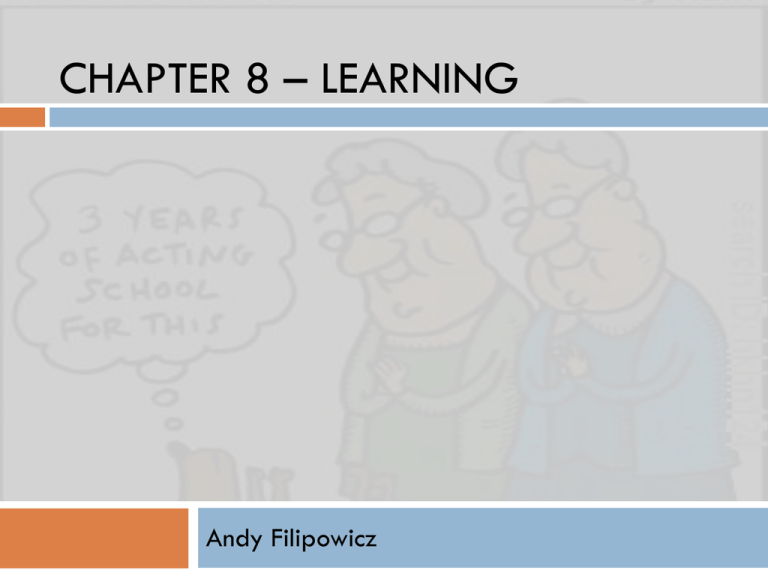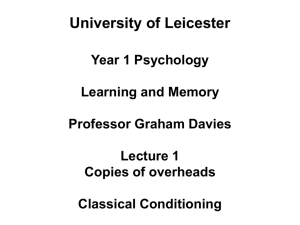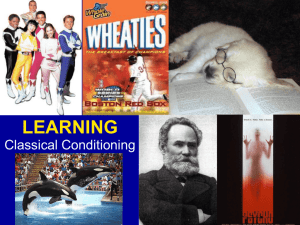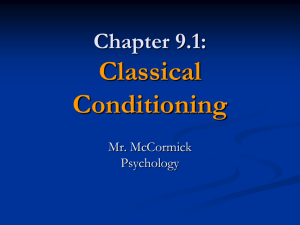Chapter 8: Conditioning and Learning
advertisement

CHAPTER 8 – LEARNING Andy Filipowicz If you want: Learning Style Quiz Learning: Defined Learning: Relatively permanent change in [observable] behavior due to experience NOT temporary changes due to disease, injury, maturation, or drugs As class moves on, determine what you are learning about the balloons… Learning Processes Behaviorism (today) Classical conditioning (today) Operant conditioning (next time) Other forms of learning (time after) Behaviorism The view that psychology should restrict its efforts to studying observable behaviors, not mental processes. Founded by John Watson Thought that all human behavior is a result of conditioning or due to past experience and environmental influences. Claimed he could take any child and train him to become any type of specialist. ?What famous study did Watson do? Classical Conditioning & Ivan Pavlov Russian physiologist – digestion/saliva! Conditioned dogs by mistake An apparatus for Pavlovian conditioning. A tube carries saliva from the dog’s mouth to a lever that activates a recording device (far left). During conditioning, various stimuli can be paired with a dish of food placed in front of the dog. The device pictured here is more elaborate than the one Pavlov used in his early experiments. Classical Conditioning: Definitions Unconditioned Stimulus (US): a stimulus that has the ability to produce a specified response before conditioning begins. (FOOD) Unconditioned Response (UR): the response produced by the US. (SALIVATION PRODUCED BY FOOD) Conditioned Stimulus (CS): an initially neutral stimulus that comes to produce a new response because it is associated with the US. (BELL) Conditioned Response (CR): the response produced by the CS. (SALIVATION PRODUCED BY THE BELL) Stimulus-Response Relationship A Simple Example What You Can Do In College... What You Can Do In College, Part II Classical Conditioning: The Elements of Associative Learning Ivan Pavlov Conditioning Trial: Salivation Test Trial: Salivation Classical Conditioning: Basic Principles Acquisition Repeatedly pairing a CS with a US will produce a CR. 1 pairing = presenting the CS and then quickly presenting the US: Salivation Extinction After conditioning has taken place, repeatedly presenting the CS without the US will make the CR weaker and eventually make it disappear. X The Office Better Sound Quality? Classical Conditioning: Additional Principles Spontaneous Recovery Following extinction, the CR reappears at reduced strength if the CS is presented again after a rest period. Stimulus Generalization After a CR has been trained to a CS, that same CR will tend to occur to similar stimuli without further training; The greater the similarity, the stronger the response will be. Conditioning: Test for Generalization: Fig. 8.6 (a) Stimulus generalization. Stimuli similar to the CS also elicit a response. (b) This cat has learned to salivate when it sees a cat food box. Because of stimulus generalization, it also salivates when shown a similar-looking detergent box. Classical Conditioning Stimulus Discrimination A subject responds to the CS but not to a similar stimulus because the CS was paired with a US but the similar stimulus was presented without the US. X Extinction & Spontaneous Recovery And now a demonstration Need a volunteer who doesn’t mind being sprayed in the face with water (personal notes pg. 5) What is the US, UR, CS, CR? US = water in face UR = flinch or squint CS = sound of word “can” CR = flinch or squint Extinction… Spontaneous Recovery… Reconditioning… Another Demonstration? If time, Eye Blink Conditioning? Fig. 8.5 Higher Order conditioning takes place when a well-learned conditioned stimulus is used as if it were an unconditioned stimulus. In this example, a child is first conditioned to salivate to the sound of a bell. In time, the bell will elicit salivation. At that point, you could clap your hands and then ring the bell. Soon, after repeating the procedure, the child would learn to salivate when you clapped your hands Applying Classical Conditioning Desensitization: Exposing phobic people gradually to feared stimuli while they stay calm and relaxed Moving Images??: Systematic Desensitization (Elevator lady) Vicarious Classical Conditioning: learning to respond emotionally to a stimulus by observing another’s emotional reactions Taste Aversions A single bad experience can stay with us… Story time!!! “My frozen chicken dinner” Imagine your favorite bowl of soup… (personal notes pg.6-7) Temporal Arrangements of CS and US Delay Conditioning: The CS begins before the US and overlaps it. CS US Rank: 1st: Works the best! EX: bell rings, continues to ring as food is presented Temporal Arrangements of CS and US Trace Conditioning: The CS begins and ends before the US begins. CS US Rank: 2nd: Overall, not very good. EX: bell rings and ends just before food is presented Temporal Arrangements of CS and US Key Variable: The CS-US Interval This is the time between CS onset and US onset. CS US Obviously, longer trace = less learning For every situation, there is an optimal CS-US interval. Intervals that are too short or too long give slower conditioning. Temporal Arrangements of CS and US Backward Conditioning: The CS begins after the US begins. CS US Rank: 3rd: Not really effective either. EX: food is presented, then the bell rings Temporal Arrangements of CS and US Simultaneous Conditioning: The CS and US begin at the same time. CS US Rank: 4th: Not very good at all…why? EX: bell begins to ring at the same time the food is presented. Both begin, continue, and end at the same time. Temporal Arrangements of CS and US How these procedures rank in effectiveness: Best Delay Conditioning Trace Conditioning Backward Conditioning Worst Simultaneous Conditioning








